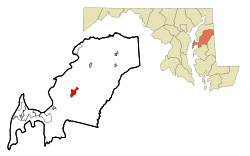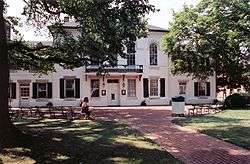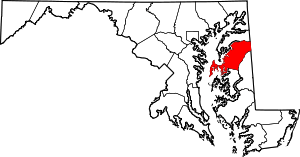Centreville, Maryland
| Centreville, Maryland | |
|---|---|
| Town | |
|
Queen Anne's County courthouse | |
 Location of Centreville, Maryland | |
| Coordinates: 39°2′46″N 76°3′52″W / 39.04611°N 76.06444°WCoordinates: 39°2′46″N 76°3′52″W / 39.04611°N 76.06444°W | |
| Country | United States |
| State | Maryland |
| County | Queen Anne's |
| Incorporated | 1794 |
| Area[1] | |
| • Total | 2.45 sq mi (6.35 km2) |
| • Land | 2.45 sq mi (6.35 km2) |
| • Water | 0 sq mi (0 km2) |
| Elevation | 49 ft (15 m) |
| Population (2010)[2] | |
| • Total | 4,285 |
| • Estimate (2012[3]) | 4,451 |
| • Density | 1,749.0/sq mi (675.3/km2) |
| Time zone | Eastern (EST) (UTC−5) |
| • Summer (DST) | EDT (UTC−4) |
| ZIP code | 21617 |
| Area code | 410 |
| FIPS code | 24-14950 |
| GNIS feature ID | 0597212 |
| Website | Town of Centreville website |
Centreville is an incorporated town in Queen Anne's County, Maryland, United States. Incorporated in 1794,[4] it is the county seat of Queen Anne's County.[5] The population was 4,285 at the 2010 census. The ZIP code is 21617 and the area code is 410. The local telephone exchange is 758. It hosts the Queen Anne's County Fair each summer and was home to three franchises during the existence of the Eastern Shore Baseball League—the Colts, Red Sox, and Orioles. The book Red Kayak by Priscilla Cummings is set in Centreville.
Geography
Centreville is located at 39°2′46″N 76°3′52″W / 39.04611°N 76.06444°W (39.046206, -76.064345).[6]
According to the United States Census Bureau, the town has a total area of 2.45 square miles (6.35 km2), all land.[1]
Climate
The climate in this area is characterized by hot, humid summers and generally mild to cool winters. According to the Köppen climate classification system, Centreville has a humid subtropical climate, abbreviated "Cfa" on climate maps.[7]
Demographics
| Historical population | |||
|---|---|---|---|
| Census | Pop. | %± | |
| 1870 | 915 | — | |
| 1880 | 1,196 | 30.7% | |
| 1890 | 1,309 | 9.4% | |
| 1900 | 1,231 | −6.0% | |
| 1910 | 1,435 | 16.6% | |
| 1920 | 1,765 | 23.0% | |
| 1930 | 1,291 | −26.9% | |
| 1940 | 1,141 | −11.6% | |
| 1950 | 1,804 | 58.1% | |
| 1960 | 1,863 | 3.3% | |
| 1970 | 1,853 | −0.5% | |
| 1980 | 2,018 | 8.9% | |
| 1990 | 2,097 | 3.9% | |
| 2000 | 1,970 | −6.1% | |
| 2010 | 4,285 | 117.5% | |
| Est. 2015 | 4,627 | [8] | 8.0% |
2010 census
As of the census[2] of 2010, there were 4,285 people, 1,568 households, and 1,102 families residing in the town. The population density was 1,749.0 inhabitants per square mile (675.3/km2). There were 1,694 housing units at an average density of 691.4 per square mile (267.0/km2). The racial makeup of the town was 85.0% White, 10.6% African American, 0.3% Native American, 1.4% Asian, 0.5% from other races, and 2.3% from two or more races. Hispanic or Latino of any race were 2.7% of the population.
There were 1,568 households of which 38.0% had children under the age of 18 living with them, 55.6% were married couples living together, 11.4% had a female householder with no husband present, 3.3% had a male householder with no wife present, and 29.7% were non-families. 25.1% of all households were made up of individuals and 10.8% had someone living alone who was 65 years of age or older. The average household size was 2.60 and the average family size was 3.12.
The median age in the town was 39.5 years. 27.5% of residents were under the age of 18; 5.2% were between the ages of 18 and 24; 26% were from 25 to 44; 23.4% were from 45 to 64; and 17.9% were 65 years of age or older. The gender makeup of the town was 47.6% male and 52.4% female.
2000 census
As of the census[10] of 2000, there were 1,970 people, 807 households, and 497 families residing in the town. The population density was 937.9 people per square mile (362.2/km²). There were 866 housing units at an average density of 412.3 per square mile (159.2/km²). The racial makeup of the town was 78.68% White, 19.24% African American, 0.10% Native American, 0.56% Asian, 0.15% from other races, and 1.27% from two or more races. Hispanic or Latino of any race were 0.81% of the population.
There were 807 households out of which 27.5% had children under the age of 18 living with them, 42.4% were married couples living together, 16.1% had a female householder with no husband present, and 38.4% were non-families. 32.8% of all households were made up of individuals and 15.0% had someone living alone who was 65 years of age or older. The average household size was 2.25 and the average family size was 2.84.
In the town the age distribution of the population shows 21.7% under the age of 18, 5.9% from 18 to 24, 28.6% from 25 to 44, 21.8% from 45 to 64, and 22.0% who were 65 years of age or older. The median age was 41 years. For every 100 females there were 88.2 males. For every 100 females age 18 and over, there were 79.7 males.
The median income for a household in the town was $41,100, and the median income for a family was $55,595. Males had a median income of $37,011 versus $25,625 for females. The per capita income for the town was $20,630. About 8.1% of families and 15.4% of the population were below the poverty line, including 17.3% of those under age 18 and 17.4% of those age 65 or over.
History
The origin of Centreville's name is a seemingly simple one. The town's official website provides some insight on its derivation. "In 1782, an Act of the Assembly authorized the removal of the county seat from Queenstown, Maryland to a more central part of the county.
However, there is a little more to the story. Saint Paul's Parish was established on the site that would later become known as Centreville, Maryland.[11] It was almost 100 years later, in 1782, that the Maryland State Assembly passed an Act to relocate both the courthouse and all government functions of the county to Centreville from Queenstown, making Centreville the new county seat.[12]
However, it took a decade for the appropriate land to be acquired and for the change to take place. A plantation called Chesterfield was chosen as the land to use for the new town which would hold the county's courthouse. Once the town and court house were completed, on the first of June 1796, the county court, "ordered [the courthouse] to be ‘taken, held and deemed to be the proper Court House of Queen Anne's County’".[12]
In 1782, the Queen Anne's county courthouse was moved from its original location in Queenstown, Maryland to an area that would, twelve years later, be named Centreville. The building's location, at the head of the Corsica River, encouraged population growth in the area.[13]
Centreville became an incorporated town in 1794, two years after the courthouse was completed. At the same time, the town laid out, including four streets that remain today: MD 213, S. Liberty St., N. Commerce St., Water St. (MD 304).[13]
Once Centreville was officially home to Queen Anne's county government, lawmakers and officials decided it was appropriate to name the new town in accordance with the new location. Centreville (named partly due to the town's central location) was also chosen because of its prime location on the Corsica River. Easy access to shipping, trading, and naval waters allowed the town to flourish and to become an important Maryland location.[14]
Today, Centreville is the largest town in Queen Anne's county, with a population of 2,097. Many residents of the town work in some capacity to supply public officials and farmers with the resources necessary to maintain Centreville's economy and preserve its place as a place in Maryland.[13] The Maryland Municipal League's Website, "The Association of Cities and Towns", notes that Centreville's, "[h]istory is reflected in the diverse architecture seen along the streets of the town—elegant Victorian homes with their wrap-around porches, neo-classical public buildings, late-19th-century commercial rows, late-20th-century institutional and government structures, and all the variations and curiosities in between".[14]
Much of the town was added to the National Register of Historic Places as the Centreville Historic District in 2004.[15]
In addition to the Centreville Historic District, Bachelor's Hope, Captain's Houses, Centreville Armory, Jackson Collins House, Content, Female Seminary, Keating House, Lansdowne, Lexon, Capt. John H. Ozmon Store, Readbourne, Reed's Creek Farm, and Stratton are listed on the National Register of Historic Places.[15]
Courthouse
The oldest courthouse in continuous use, and one of two 18th century courthouses in Maryland, the Queen Anne's County Courthouse is located at 120 North Commerce Street. The location for the courthouse, and for the town of Centerville, was a piece of land on which Judge Joseph Hopper Nicholson lived on at the time.[16] In 1792 the Flemish-bond brick building was completed.[13] At the time it was composed of four rooms, two in the center and one on each side. The courthouse's use was increasing, so, in 1876 it was renovated and remodeled to add more space.[17] An iron balcony was also added to the second story.[13]
A unique feature of the courthouse is a gold eagle on the main building's rooftop. The eagle is thought to be symbolic of America's freedom from England and relays the idea of independence.[16] In Judge John W. Sause, Jr.'s essay, "Why the Eagle", he connects the idea of freedom and the importance of the United States’ seal to the courthouse's eagle. Here, he writes, "Executed by an unknown hand, undoubtedly that of an artisan rather than an artist…our eagle looked down upon the comings and going of the courtyard, the tears and smiles of its citizens and the successes and failures of the political system which it was designed to represent".[18]
A statue of Queen Anne of England, the county's namesake, sits in front of the courthouse. Princess Anne, daughter of Queen Elizabeth II, attended the dedication (1977).[17]
Today, the courthouse remains an important figure in Centreville, Queen Anne's County, and the state of Maryland. Keeping true to its original form, the building's exterior is true to its original look.[16]
References
- 1 2 "US Gazetteer files 2010". United States Census Bureau. Archived from the original on 2012-01-24. Retrieved 2013-01-25.
- 1 2 "American FactFinder". United States Census Bureau. Retrieved 2013-01-25.
- ↑ "Population Estimates". United States Census Bureau. Archived from the original on 2013-06-17. Retrieved 2013-06-26.
- ↑ "Centreville", Queen Anne's County, 16 May 2007. Accessed 16 March 2008
- ↑ "Find a County". National Association of Counties. Archived from the original on 2011-05-31. Retrieved 2011-06-07.
- ↑ "US Gazetteer files: 2010, 2000, and 1990". United States Census Bureau. 2011-02-12. Retrieved 2011-04-23.
- ↑ Climate Summary for Centreville, Maryland
- ↑ "Annual Estimates of the Resident Population for Incorporated Places: April 1, 2010 to July 1, 2015". Retrieved July 2, 2016.
- ↑ "Census of Population and Housing". Census.gov. Archived from the original on May 11, 2015. Retrieved June 4, 2015.
- ↑ "American FactFinder". United States Census Bureau. Archived from the original on 2013-09-11. Retrieved 2008-01-31.
- ↑ "Centreville Archived October 8, 2007, at the Wayback Machine.." Historic Sites and Landmarks. 16 March 2008.
- 1 2 "Queen Anne’s County Courthouse." Circuit Court for Queen Anne's County 2006 18 March 2008.
- 1 2 3 4 5 Arnett, Earl, Brugger, Robert J., and Edward C. Papenfuse. Maryland: A New Guide to the Old Line State (2nd ed.) The Johns Hopkins University Press, Baltimore 1999 p. 153-154
- 1 2 "Centreville Archived March 7, 2008, at the Wayback Machine.." The Maryland Municipal League. 2008. 17 March 2008.
- 1 2 National Park Service (2008-04-15). "National Register Information System". National Register of Historic Places. National Park Service.
- 1 2 3 "The Queen Anne’s County Court House" Circuit Court for Queen Anne's County. 18 April 2008.
- 1 2 "Centreville." Historic Sites Consortium of Queen Anne's County. 18 April 2008 18 April 2008
- ↑ MacGlashan, Scott. "Re: Courthouse information." Judge John W. Sause, Jr. "Why the Eagle" E-mail to the author. 22 April 2008
External links
- Map of Centreville, from the Historical Society of Kent County collection
- Town of Centreville website

